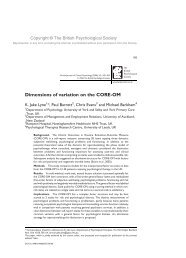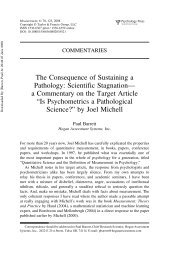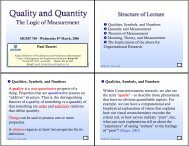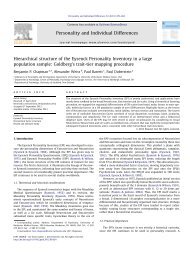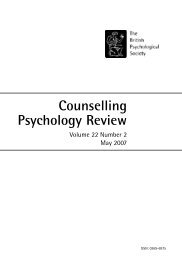Psychophysiological Methods - Paul Barrett
Psychophysiological Methods - Paul Barrett
Psychophysiological Methods - Paul Barrett
- No tags were found...
You also want an ePaper? Increase the reach of your titles
YUMPU automatically turns print PDFs into web optimized ePapers that Google loves.
Breakwell-3389-Reference.qxd 2/7/2006 9:03 PM Page 498Lundh, L. G. & Sperling, M. (2002). Social anxiety and the post-event processing ofsocially distressing events. Cognitive Behaviour Therapy, 31, 129–134.Lunt, P. (1996). Discourse of savings. Journal of Economic Psychology, 17, 677–690.Lunt, P., & Livingstone, S. (1996). Focus groups in common and media research. Journalof Communication, 42, 78–87.Lynn, P., Beerten, R., Laiho, J. & Martin, J. (2001). Recommended standard final outcomecategories and standard definitions of response rate for social surveys. WorkingPapers of the Institute for Social and Economic Research 2001–23. University ofEssex, Colchester.Macmillan, N. A. & Creelman, C. D. (2005). Detection theory: A user’s guide (2nd ed.).Mahwah, NJ: Lawrence Erlbaum.Madill, A. & Doherty, K. (1994). ‘So you did what you wanted then’: Discourse analysis,personal agency, and psychotherapy. Journal of Community & Applied SocialPsychology, 4, 261–273.Magina, C. A. (1997). Some recent applications of clinical psychophysiology. InternationalJournal of Psychophysiology, 25(1), 1–6.Manis, J. G. & Metzer, B. N. (1967). Symbolic interactionism: A reader in social psychology.Boston: Allyn & Bacon.Marascuilo, L. A. & Levin, J. R. (1983). Multivariate statistics in the social sciences.Monterey, CA: Brooks/Cole.Markham, A. N. (2004). Internet communication as a tool for research. In D. Silverman(Ed.), Qualitative research: Theory, method and practice (pp. 95–124). London: Sage.Marsh, P., Rosser, E. & Harré, R. (1978). The rules of disorder. London: Routledge &Kegan <strong>Paul</strong>.Marshall, C. & Rossman, G. B. (1999). Designing qualitative research (3rd ed.). London:Sage.Maruyama, G. M. (1997). Basics of structural equation modeling. London: Sage.Mather, G., Verstraten, F. & Anstis, S. (Eds) (1998). The Motion Aftereffect. A modernperspective. Cambridge, MA: MIT Press.May, V. (2004). Narrative identity and the re-conceptualization of lone motherhood.Narrative Inquiry, 14(1), 169–189.McAdams, D. P. (1999). Personal narratives and the life story. In O. P. John & L. A. Pervin(Eds), Handbook of personality: Theory and research (2nd ed.). New York: GuilfordPress.McAdams, D. P. (2004). The redemptive self: Narrative identity in America today. InD. R. Beike, J. M. Lampinen & D. A. Behrend (Eds) The self and memory (pp. 95–115).New York: Psychology Press.McCutcheon, A. L. (1987). Latent class analysis. Newbury Park, CA:Sage.McDonald, R. P. (1985). Factor analysis and related methods. Hillsdale, NJ: Erlbaum.McLachlan G. J. (2004). Discriminant analysis and statistical pattern recognition.Chichester: Wiley.McTaggart R. (2005). Is validity really an issue for participatory action research. InB. Cooke & J. Wolfram Cox, Fundamentals of action research. London: Sage.Mcllenberg, G. J. (1991). A note on simple gain score precision. Applied PsychologicalMeasurement, 23, 87–89.498 RESEARCH METHODS IN PSYCHOLOGY



